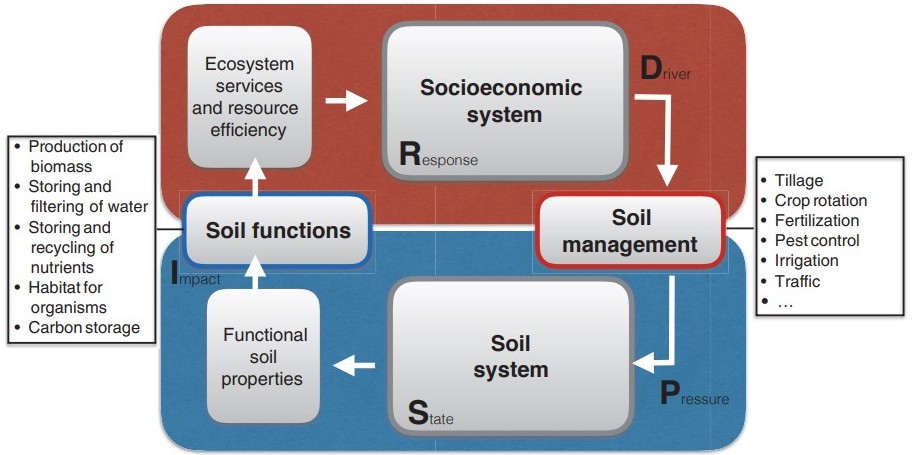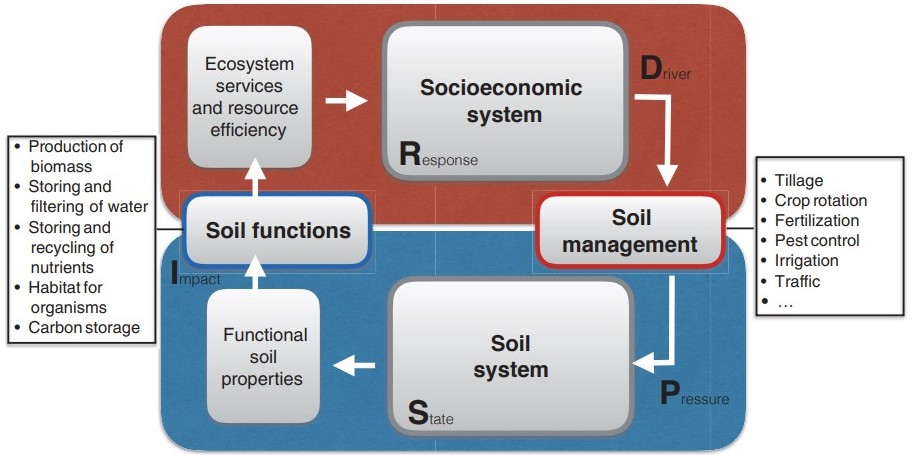Innovative Soil Management Practices across Europe
Innovative Soil Management Practices across Europe (i-SoMPE)
Innovative soil management practices can increase the sustainability and climate resilience of agriculture. As part of the i-SoMPE project, existing knowledge on various soil management practices and systems was compiled in an inventory. In addition, the potentials and limitations of the practices were evaluated.
Agriculture is a major user of soil as a natural resource and its interaction with the environment is a complex one. Grassland and arable land cover 39% of the total surface area of Europe. Soil management is a cornerstone of agriculture and plays a key role in both a cultivated (soil) ecosystem and in the socio-economic system (Figure 1). An inventory of 49 scientifically well-studied agricultural practices was compiled in a comprehensive review of the literature.
Expert surveys were conducted to determine the prevalence of the inventoried practices in 24 European countries. In addition, the involved partners added 51 practices or specific case studies to the inventory. The final inventory thus describes 100 practices, including their qualitative impacts on the environment and agricultural yields as well as any existing knowledge gaps.
Qualitative stakeholder interviews were conducted to identify the socio-economic barriers limiting or promoting the spread of four practices or system approaches, viz. conservation agriculture, cover-cropping without herbicide application or ploughing, drip irrigation and low-emission slurry application.
A method for the geodata-based determination of the biophysical potential for application of soil management practices was developed and applied to three case studies (cover cropping, drip irrigation and low-emission slurry application).
The results of i-SoMPE exemplify the large number and diversity of soil management practices and systems in Europe. In addition, we found that the potential for application of the vast majority of practices has not been exhausted, i.e. there is still considerable potential for optimisation in terms of sustainable soil management. Our investigations furnish an example of how the region-specific biophysical and socio-economic context should be taken into account when identifying and promoting specific soil management practices. In general, stakeholders stressed the relevance of networks for sharing knowledge and experience in order to promote the examined practices. A major socio-economic barrier to the application of the practices studied are the costs and risks associated with their application. Both are issues that should be taken into account when designing policy-based or market-based measures.
Publications
- Report on the method for geodata-based determination of the potential for application of practices
(at request)
- Final report of the project
(at request)
Participating organisations
- Austria - AGES - Austrian Agency for Health and Food Safety
- Belgium (Flanders) - ILVO - Instituut voor Landbouw-, Visserij- en Voedingsonderzoek
- Belgium (Wallonia) - CRA-W - Centre wallon de recherches agronomiques
- Czech Republic - CZU Prgue - Czech University of Life Sciences Prague
- Denmark - AU - Aarhus University
- Estonia - EMU - Eesti Maaülikool
- Finland - LUKE - Natural Resources Institute Finland
- France - INRAE - France's National Research Institute for Agriculture, Food and Environment
- Germany - THÜNEN - Thünen Institute
- Hungary - ATK - Centre for Agricultural Research
- Ireland - Teagasc - Teagasc
- Italy - CREA - Council for Agricultural Research and Economics
- Latvia - UL - University of Latvia
- Lithuania - LAMMC - Lithuanian Research Centre for Agriculture and Forestry
- Norway - NIBIO - Norwegian Institute of Bioeconomy Research
- Poland - IUNG-PIB - Institute of Soil Science and Plant Cultivation – State Research Institute
- Portugal - INIAV - National Institute for Agrarian and Veterinarian Research I. P. / Instituto Nacional de Investigação Agrária e Veterinária, I. P.
- Slovakia - NAFC - National Agriculture and Food Centre
- Slovenia - ULBF - University of Ljubljana
- Spain - CSIC-IRNASA - Spanish National Research Council - Institute of Natural Resources and Agrobiology of Salamanca
- Sweden - SLU - Swedish University of Agricultural Sciences
- Switzerland - AGS - Agroscope
- The Netherlands - WR - Wageningen Research
- Turkey - TAGEM - Republic of Turkey, Ministry of Agriculture and Forestry (MAF) General Directorate of Agricultural Research and Policies
- United Kingdom - AFBI - Agri-Food and Biosciences Institute







